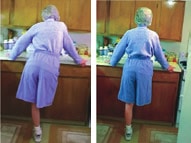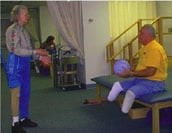Senior Step – Volume 1, 2004 | Download PDF
by Melissa Wolff-Burke, EdD, PT, ATC, and Elizabeth Cole, PT
 Keep Moving
Keep Moving
The previous article discussed exercises to help you maintain the range of motion (ROM) in your limbs and back and help you get moving again after an amputation. Many of those activities can be made more challenging by adding weight, not using any object for support, standing instead of sitting, or even standing on one leg. If you have already mastered those activities, you can keep moving by trying the following advanced exercises. As always, please be sure to check with your physician or physical therapist before beginning any exercises. Your fitness level, your general health, and the condition of your residual limb will all play a role in how rigorously you can exercise. A qualified health professional can teach you how to stay within your target heart range.
Strength Exercises
Strength is needed in each leg, your arms and your trunk (stomach and back). In addition to your legs, your stomach and back muscles play a crucial role in standing and moving. If your trunk is not strong, it will not be able to hold up to the demands you make on it all day every day.
Seated push up

Partial squats

Wall squat (More advanced)

Pelvic tilt

Balance Exercises
Advanced Exercises 05One of the most difficult rehabilitation activities is retraining you and your brain to accept weight into the socket of your prosthesis. To use your prosthesis and its foot and knee components to their fullest advantage, however, you must put all of your weight into the socket and use all of your leg muscles to control it. Though it will be difficult to learn to use your remaining leg muscles to balance on each leg while standing and walking, it will pay off in a smoother, less tiring gait.
Even weight bearing
While standing in line, shaving, or brushing your teeth, think about how much weight you have on each leg. Do you stand with most of your weight on your unaffected leg? Many people with an amputation shift all of their weight onto the unaffected leg and use the prosthesis only as a perch. Stand with your weight evenly on both legs while performing one typical daily task, such as talking on the telephone. By increasing your awareness and changing this one simple habit, you can improve your balance on a daily basis.
All fours

Kick ball

Hip lift

Uneven surfaces

Agility Exercises
Once you have mastered balance activities, you will find that you are moving more easily. It is also likely that you will be doing more, and you may find that you occasionally need to move faster, slower, backwards or sideways. By practicing the following exercises and varying the speed and step length, you will improve your agility and accomplish tasks with more confidence.
Braiding

Circle
walk around a chair in each direction.
Ball toss

Endurance Exercises
You have already been improving your endurance by working on your range of motion, strength, balance and agility. Every time you do an extra repetition, use a heavier weight, or spend more time exercising, you are improving your endurance. To focus more on endurance, you simply need to work a little harder and a little longer at the things you have already been doing. You might also add an aerobic activity. If you have access to a stationary bike, a treadmill, a rower or a pool, you can use it to improve your endurance. And, of course, there is always just plain walking. It is a good idea to seek the assistance of a health professional to determine your current level of fitness and your target heart rate (THR). You don’t want to stress your heart too much or too little. Once you learn your THR and how to take your pulse, you will be able to do effective endurance activities with confidence.
Stationary bike
If you have a stationary bike, get on it! Stop using it as a clothes rack. You can ride a bike with one leg. It would, however, help to have a strap to hold your foot in place. If you cannot get on your bike, how about placing it on a table top, sitting behind the table, and moving the pedals with your hands?
Conclusion
If you are interested in doing more exercise or have specific concerns, a physical therapist who has experience working with people with amputations can help you. If, on the other hand, your needs are more general and you would like to exercise at home, several books and videos can be purchased through the Amputee Coalition to help you.
If you can set a goal, break it down into small bits, and make exercise a part of your daily plan, you will find that it becomes a good habit. Set aside some time each day to work on one of these activities, get a friend to join you, play some music and have some fun. Applaud your efforts, great and small, and you will keep moving.


 Keep Moving
Keep Moving